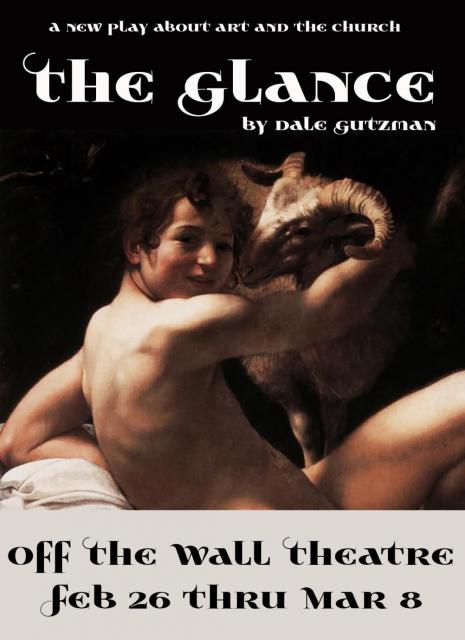
Milwaukee theatergoers looking for something new, thought-provoking, a bit exotic and a bit erotic can do no better than to head to Off the Wall Theater for the world premiere of The Glance. Artistic director Dale Gutzman has done it again – created a show that gives viewers an inside look at the talent and mind of Caravaggio, now considered one of the greatest artists in history. The play, which is being performed in a minuscule, 40-seat theater, is so engrossing that it does not allow the audience to look away for even a second of its two-hour running time. The Glance, written and directed by Gutzman, is set in Milan, Italy in the 1500s. This is a place that alternately displays the best and worst of mankind: the sacred and the profane, the kindness and the cruelty, the debauchery and heavenly artistic gifts, the excess and the poverty, the control and the rebellion.
Over it all looms the nemesis of the Black Plague, first described in the play by Father D’Angelo (Randall T. Anderson). He appears wearing the beaklike black mask (which were worn by those who searched for new victims of the disease) and a black cape. He makes his way to the grotto-like studio of Michael Merisi (a.k.a. Caravaggio), and who is represented here by a character known as “the artist” (Max Williamson). He is soon joined by a monk (Mark Ninneman) and the Archbishop Borromeo (Michael Pocaro). The archbishop is curious to see Caravaggio’s work-in-progress for the church.
Again, the audience is so close to the action that we can almost imagine the studio’s smell of paint and sweat. When tempers flare and props start flying, it’s almost as if we cringe in reaction almost like the play’s characters do.
In a nicely written and designed color insert into the show’s program, we learn that Caravaggio’s work represented a new, lifelike reality into art. Unlike the idealized images favored by other artists at the time, Caravaggio used models that may have been his lovers (of either sex), homeless people, or prostitutes. In the paintings, their likenesses represent religious figures such as the virgin Mary, Christ, or St. Frances, to name a few. They were often shown as nude, or partially nude, figures; and their poses could be considered suggestive.
At the same time, Catholic church leaders dictated a return to more traditional (and modest) paintings, and ones that were more idealized than realistic. In short, they considered Caravaggio’s work too realistic and erotic for the masses. Onstage, Gutzman rightly notes the hypocrisy of this era. Although Caravaggio’s paintings were officially rejected by the church, they were snapped up by the clergy (such as bishops, cardinals, and popes) for their private collections.
As the play unfolds, we are introduced to several other key figures. Prominent among them is Giovanni Merisi (Nathan Danzer), Caravaggio’s brother, who sometimes served as one of his brother’s models. Other key characters, especially in the second act, are Julietta (Abigail Fuchs), a local baker’s daughter whose family is wiped out by the plague, and the Countess of Colonna (Amber Regan), who has lost her own family and therefore clings to the childhood connection with Caravaggio. Another minor role is played by Teddi Gardener as Marco.
The plot thickens with suspense as Caravaggio, who is wanted for murder in a nearby city, attempts to hide out in his studio. He also hides his own feelings of love and tenderness towards Julietta, who clearly loves him, because he knows his brother has strong feelings for her, as well.
As “the artist,” Max Williamson gives the performance of his career. Since the audience is so close to the action, Williamson rightly downplays his reactions to things around him. He strides about the set, naked from the waist up, his flesh smeared with streaks of paint. He keeps his emotions in check to the point where one might forget that he is a live actor, not a film actor. The other performers follow suit, although the clergy (Off the Wall favorites Michael Pocaro and Randall T. Anderson) tend to give somewhat broader performances. The most sensitively drawn portrait may be Nathan Danzer as Giovanni. He is somewhat more animated than his famous artist brother, and Danzer conveys a sense of carefree charm. Together, the brothers display a family bond that is both convincing and tender. As Julietta, the woman desired by both men, Abby Fuchs nimbly balances her own emotions. One is never sure, until the final scene, how this lovers’ triangle is going to play out.
Another frequent actor on the Off the Wall stage, Mark Ninneman, is impressive as a monk. In relatively few lines, Ninneman aptly conveys a monk’s absolute devotion to his superiors. He is a calm, quiet and stalwart presence who enhances all his scenes.
If you have never seen one of Dale Gutzman’s plays, this is definitely one not to miss. In every respect, The Glance is the work of a seasoned playwright. Gutzman exemplifies a deft hand at capturing all the elements of dramatic tension and maintaining them until the play’s satisfying conclusion.
